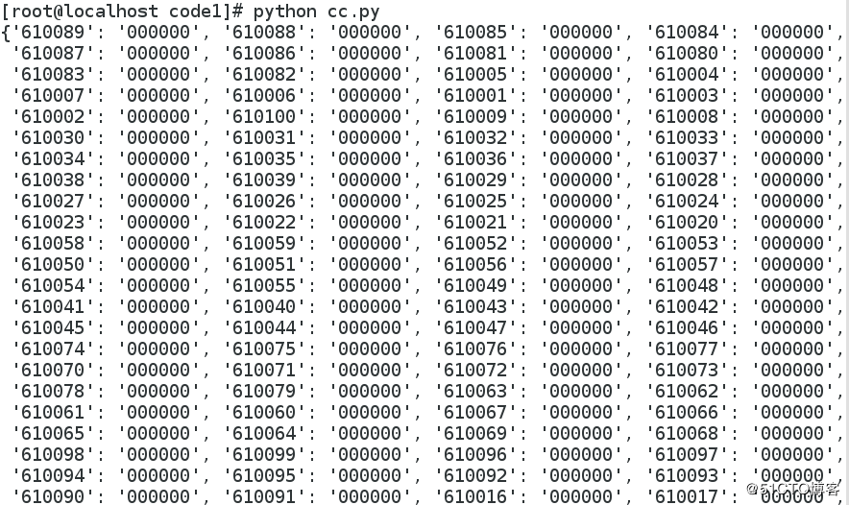Python中的字典及其应用
发布时间:2019-09-17 07:43:55编辑:auto阅读(2208)
一.字典创建
1.赋值创建字典
#赋值创建字典,key-value----键值对
In [1]: d = {'key1': 'value', 'key2': 'value2'}
In [2]: print d
{'key2': 'value2', 'key1': 'value'}
In [3]: services = {'ssh': 22, 'ftp':[20, 21], 'http':[80, 8080]}
In [4]: print services
{'ftp': [20, 21], 'http': [80, 8080], 'ssh': 22}
2.通过工厂函数创建字典
In [6]: users = dict(user1='123',user2='456',user3='789')
In [7]: print users
{'user2': '456', 'user3': '789', 'user1': '123'}
3.通过字典的fromkeys方法创建字典,所有元素有一个默认值
#如果没有指定默认值,默认值为None
In [8]: print {}.fromkeys('hello')
{'h': None, 'e': None, 'l': None, 'o': None}
#给每个元素设置默认值为'123'
In [9]: print {}.fromkeys(['user1', 'user2', 'user3'], '123')
{'user2': '123', 'user3': '123', 'user1': '123'}
应用案例: 生成多个银行卡号,并初始化密码为"000000"# 卡号由 6 位组成, 前 3 位是 610 , 后面的依次是 001, 002, 003...100
[root@localhost code1]# vim cards.py
#!/usr/bin/env python
#coding:utf-8
cards = []
for i in range(1,101):
a = '610%.3d' %(i)
cards.append(a)
print {}.fromkeys(cards,'000000')

二.分析字典的特征(跟元组和列表比较)
-字典不能索引和切片,因为字典是无序的数据类型;
-字典不支持重复和连接;
-字典支持成员操作符: 判断字典的key值是否在字典中存在; in, not in
三.字典的增删改查
1.增
-字典名[key] = value
-d.update(a=1, b=2)
-d.update({'a':1, 'b',2})
-d.setdefault('a', 1)
(1)通过字典名[key]=value,将key-value添加到字典中
In [10]: service = {'ftp':[20,21]}
In [11]: service['http'] = [80,8080]
In [12]: service
Out[12]: {'ftp': [20, 21], 'http': [80, 8080]}
(2)update方法实现添加:key存在,覆盖value值,否则添加
In [21]: service = {'ftp':[20,21]}
In [22]: service1 = {'ssh':22}
In [23]: service.update(service1)
In [24]: print service
{'ftp': [20, 21], 'ssh': 22}
(3)update添加
In [25]: print service
{'ftp': [20, 21], 'ssh': 22}
In [27]: service.update(http=[80,8080],ftp=23)
In [28]: print service #覆盖value值
{'ftp': 23, 'http': [80, 8080], 'ssh': 22}
(4)setdefault实现添加:
key存在,不覆盖value值,否则,添加
In [30]: service = {'ftp':[20,21]}
In [32]: service.setdefault('ftp',23)
Out[32]: [20, 21]
In [33]: print service
{'ftp': [20, 21]} #key存在不覆盖value值
In [34]: service.setdefault('ssh',23)
Out[34]: 23
In [35]: print service
{'ftp': [20, 21], 'ssh': 23} #key不存在,添加
2.改
-字典名[key]=value
-d.update({'a':2, 'b':3})
-d.update(a=2, b=3)
3.查
-查看key值;
-查看value值;
-查看key-value键值对;
-查看key是否存在;
(1)查看key值
In [38]: services
Out[38]: {'cc': 23, 'ftp': [20, 21], 'http': [80, 8080], 'ssh': 22}
In [40]: services.keys()
Out[40]: ['cc', 'ftp', 'http', 'ssh']
In [41]: services.viewkeys()
Out[41]: dict_keys(['cc', 'ftp', 'http', 'ssh']) #给key起名字
In [45]: services.iterkeys()
Out[45]: <dictionary-keyiterator at 0x2887730>
(2)查看value值
n [46]: services.values()
Out[46]: [23, [20, 21], [80, 8080], 22]
(3)查看key-value键值对
In [47]: services.items()
Out[47]: [('cc', 23), ('ftp', [20, 21]), ('http', [80, 8080]), ('ssh', 22)]
(4)查看key是否存在
In [48]: services.has_key('http')
Out[48]: True
In [49]: services.has_key('sttp')
Out[49]: False
(5)查看指定key对应的value值
如果key不存在,不报错;
如果key存在,返回value值
In [50]: services.get('sttp') #key不存在,不报错
In [51]: services.get('http')
Out[51]: [80, 8080] #key存在,返回value值
In [52]: services['sttp'] #key不存在,直接报错
KeyError Traceback (most recent call
In [54]: services['http'] #key存在,返回value值
Out[54]: [80, 8080]
4.删
d.pop(key) #删除指定 key 的字典元素;
d.popitem() #随机删除字典的 key-value 元素 ;
del d[key] #删除指定 key 的字典元素;
d.clear() #清空字典元素
四.循环遍历字典
In [82]: service
Out[82]: {'ftp': 20, 'http': [80, 8080], 'ssh': 22}
1.遍历key-value的值
In [85]: for i,j in service.items():
....: print i,j
....:
ftp 20
http [80, 8080]
ssh 22
2.默认情况下,遍历字典的key值
In [86]: for i in service:
....: print i
....:
ftp
http
ssh
五.字典的应用
应用1: 通过字典实现case语句
-目前python不支持case语句;
-实现case语句的两种方式:
-if...elif...elif...else...
-字典实现
#!/usr/bin/env python
#coding:utf-8
"""
# 实现四则运算
# - 用户分别输入第一个数字,运算操作符,第三个数字;
# - 根据用户的运算操作打印出运算结果;
# """if...elif...elif...else... 实现:
from __future__ import division
num1 = input()
ope = raw_input()
num2 = input()
if ope == '+':
print num1+num2
elif ope == '-':
print num1-num2
elif ope == '*':
print num1*num2
elif ope == '/':
print num1/num2
else:
print 'error operator'字典实现 case 语句
#coding:utf-8
"""
实现四则运算
用户分别输入第一个数字,运算操作符,第三个数字;
根据用户的运算操作打印出运算结果;
"""
#!/usr/bin/env python
#coding:utf-8
from future import division
num1 = input()
ope = raw_input()
num2 = input()
d = {
"+" : num1+num2,
"-" : num1-num2,
"" : num1num2,
"/" : num1/num2,
}
if not ope in d:
print "error operator"
else:
print d[ope]
应用2:用户管理系统
-1.注册新用户
-如果注册用户已经存在,则报错;
-需要填写信息: name, passwd, gender, email,age;
-2.用户登录 要求同之前写的用户登录系统
-3.注销用户 用户注销时,需要输入用户名和正确的用户密码
-4.显示用户信息 显示系统中存在所有已经注册用户的信息;
-5.退出系统。
欢迎评论
上一篇: 学习python不错的书
下一篇: Python日历模块总结
- openvpn linux客户端使用
51676
- H3C基本命令大全
51335
- openvpn windows客户端使用
41768
- H3C IRF原理及 配置
38546
- Python exit()函数
33021
- openvpn mac客户端使用
30040
- python全系列官方中文文档
28710
- python 获取网卡实时流量
23693
- 1.常用turtle功能函数
23613
- python 获取Linux和Windows硬件信息
21976
- Python搭建一个RAG系统(分片/检索/召回/重排序/生成)
2165°
- Browser-use:智能浏览器自动化(Web-Agent)
2866°
- 使用 LangChain 实现本地 Agent
2390°
- 使用 LangChain 构建本地 RAG 应用
2333°
- 使用LLaMA-Factory微调大模型的function calling能力
2871°
- 复现一个简单Agent系统
2343°
- LLaMA Factory-Lora微调实现声控语音多轮问答对话-1
3132°
- LLaMA Factory微调后的模型合并导出和部署-4
5140°
- LLaMA Factory微调模型的各种参数怎么设置-3
4970°
- LLaMA Factory构建高质量数据集-2
3551°
- 姓名:Run
- 职业:谜
- 邮箱:383697894@qq.com
- 定位:上海 · 松江
